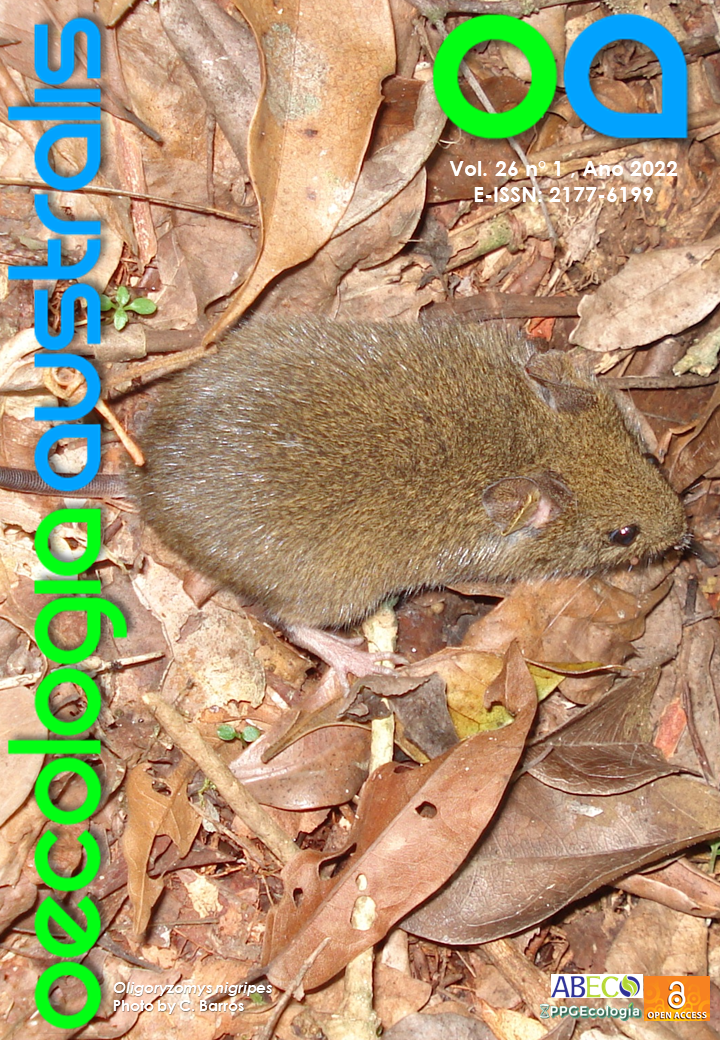PREDATION OF SCOLOPENDRA VIRIDICORNIS (NEWPORT 1844) (CHILOPODA, SCOLOPENDRIDAE) BY BOTHROPS ERYTHROMELAS (AMARAL 1923) (SQUAMATA, VIPERIDAE) IN THE CAATINGA, NORTHEAST BRAZIL
DOI:
https://doi.org/10.4257/oeco.2022.2601.07Keywords:
centipede, diet, roadkill, snake, venomousAbstract
Bothrops erythromelas is a terrestrial Viperidae snake that feeds mainly on small lizards, anurans and mammals. Scolopendra viridicornis is a highly venomous centipede with a strictly carnivorous diet, feeding on invertebrates and even small vertebrates. On March 1th, 2016, during a herpetological survey we observed a subadult male B. erythromelas road-killed with a dead centipede popping out from its body. We believe that the centipede was ingested by the snake, and broke out through the snake's body when it was run over. Our report is the first predation record between these two venomous species.
Downloads
References
Andrade, D. V. & Abe, A. S. 1999. Relationship of venom ontogeny and diet in Bothrops. Herpetologica, 55: 200–204.
Arsovski, D., Ajtic, R., Golubovic, A., Trajceska, I., Dordevic, S., Andelkovic, M., & Tomovic, L. 2014. Two fangs good, a hundred legs better: juvenile viper devoured by an adult centipede it had ingested. Ecologica Montenegrina. 1(1), 6–8.
Campbell, J. A., & Lamar, W. W. 1989. The venomous reptiles of Latin America.
Carrasco, P. A., Grazziotin, F. G., Farfan, R. S. C., Koch, C., Ochoa, J. A., Scrocchi Manfrini, G. J., & Chaparro, J. C. 2019. A new species of Bothrops (Serpentes: Viperidae: Crotalinae) from Pampas del Heath, southeastern Peru, with comments on the systematics of the Bothrops neuwiedi species group. Zootaxa 4565 (3), 301–344.
Costa, H. C. & Bérnils, R. S. 2018. Répteis do Brasil e suas Unidades Federativas: Lista de espécies. Herpetologia Brasileira, 8(1), 11–57.
Edgecombe, G. D. & Giribet, G. 2007. Evolutionary Biology of Centipedes (Myriapoda: Chilopoda). Annual Review of Entomology, 52, 151–170. DOI: 10.1146/annurev.ento.52.110405.091326
Hickman, C., Roberts, L. & Larson, A. 1997. Integrated Principles of Zoology. Dubuque, IA, USA, Wm. C. Brown Publishers. p. 912.
Lira-da-Silva, R. M., Mise, Y. F., Casais-e-Silva, L. L., Ulloa, J., Hamdan, B., & Brazil, T. K. 2009. Serpentes de importância médica do nordeste do Brasil. Gazeta Médica da Bahia, 79 (1), 7–20.
Malta, M.B., Lira, M.S., Soares, S.L., Rocha, G.C., Knysak, I., Martins, R., Guizze, S.P.G., Santoro, M.L. & Barbaro, K.C. 2008. Toxic activities of Brazilian centipede venoms. Toxicon 52, 255–263. DOI: 10.1016/j.toxicon.2008.05.012
Martins, M., Marques, O. A., & Sazima, I. V. A. N. 2002. Ecological and phylogenetic correlates of feeding habits in Neotropical pitvipers of the genus Bothrops. Biology of the Vipers, 307–328.
Molinari, J., Gutiérrez, E. E., Ascenção, A. A., Nassar, J. M., Arends, A. & Márquez, R. J. 2005. Predation by giant centipedes, Scolopendra gigantea, on three species of bats in a venezuelan cave. Caribbean Journal of Science 41, 340–346.
Mora-Obando, D., Salazar-Valenzuela, D., Pla, D., Lomonte, B., Guerrero-Vargas, J. A., Ayerbe, S., & Calvete, J. J. 2020. Venom variation in Bothrops asper lineages from north-western South America. Journal of Proteomics, 229, 103945.
Moura, L. O. G., Machado, C. M. S., Conceição, B. M., Silva, A. O., Santana, A. F., & Faria, R. G. 2015. Predation of Ameivulla ocellifera (Teiidae) by (Scholopendridae: Scolopendra sp.) in the vegetation of the Caatinga biome, northeastern Brazil. Herpetology Notes, 8, 389–391. DOI: 10.1590/1676–0611–BN–2020–1137
Nogueira, C. C., Argôlo, A. J., Arzamendia, V., Azevedo, J. A., Barbo, F. E., Bérnils, R. S. & Martins, M. 2019. Atlas of Brazilian snakes: verified point-locality maps to mitigate the Wallacean shortfall in a megadiverse snake fauna. South American Journal of Herpetology, 14(sp1), 1–274.
Ruppert, E. & Barnes, R. 1994. Invertebrate Zoology. New York, USA, Saunders College Publishing. p. 1056.
Silva, K. M. P. D., Almeida-Santos, S. M. D., & Bertani, R. 2017. Hundred legs good, two fangs better: adult centipede (Scolopendridae) devoured by a juvenile Amazon lancehead, Bothrops atrox (Viperidae). Acta Amazonica, 47(2), 171–174. DOI: 10.1590/1809–4392201601884
Silva, M. B., Schattner, M., Ramos, C. R., Junqueira-de-Azevedo, I. L., Guarnieri, M. C., Lazzari, M. A., Sampaio, C. A. M., Pozner, R. G., Ventura, J. S., Ho, P. L., and Chudzinski-Tavassi, A. M. 2003. A prothrombin activator from Bothrops erythromelas (jararaca-da-seca) snake venom: characterization and molecular cloning. Biochemical Journal, 369(1), 129–139.
Venegas, P. J., Chávez-Arribasplata, J. C., Almora, E., Grilli, P. G., & Duran, V. 2019. New observations on diet of the South American two-striped forest-pitviper Bothrops bilineatus smaragdinus (Hoge, 1966). Cuadernos de Herpetología, 33 (1), 29–31.


